HR Research Project: Evaluating Employee Engagement at ABC Motors
VerifiedAdded on 2023/05/30
|17
|4388
|244
Report
AI Summary
This report presents an evaluation of employee engagement procedures at ABC Motors, a family-owned motor retail company. The study addresses challenges such as employee demotivation, high attrition rates, and declining revenue. It examines the current employee engagement strategies, focusing on factors like job design, organizational culture, and motivation. The research aims to understand the contribution of employee engagement to productivity, revenue, and profitability. The methodology includes surveys and interviews with stakeholders, incorporating both primary and secondary data sources. The report outlines research aims, objectives, stakeholder analysis, and a detailed action plan, culminating in findings, conclusions, and recommendations for enhancing employee engagement and improving business outcomes. The report emphasizes the importance of formal engagement procedures to boost employee morale and retention.
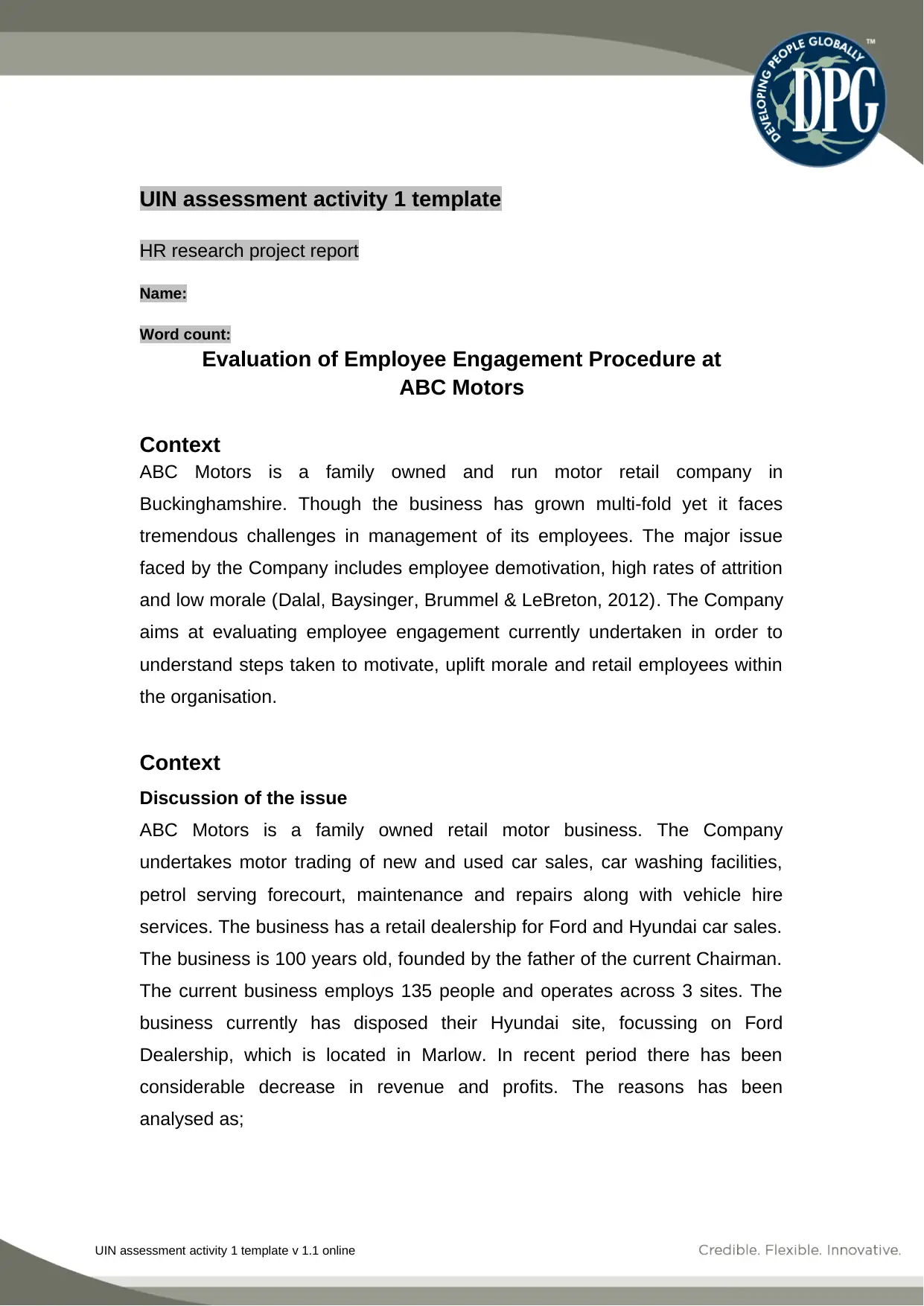
UIN assessment activity 1 template v 1.1 online
UIN assessment activity 1 template
HR research project report
Name:
Word count:
Evaluation of Employee Engagement Procedure at
ABC Motors
Context
ABC Motors is a family owned and run motor retail company in
Buckinghamshire. Though the business has grown multi-fold yet it faces
tremendous challenges in management of its employees. The major issue
faced by the Company includes employee demotivation, high rates of attrition
and low morale (Dalal, Baysinger, Brummel & LeBreton, 2012). The Company
aims at evaluating employee engagement currently undertaken in order to
understand steps taken to motivate, uplift morale and retail employees within
the organisation.
Context
Discussion of the issue
ABC Motors is a family owned retail motor business. The Company
undertakes motor trading of new and used car sales, car washing facilities,
petrol serving forecourt, maintenance and repairs along with vehicle hire
services. The business has a retail dealership for Ford and Hyundai car sales.
The business is 100 years old, founded by the father of the current Chairman.
The current business employs 135 people and operates across 3 sites. The
business currently has disposed their Hyundai site, focussing on Ford
Dealership, which is located in Marlow. In recent period there has been
considerable decrease in revenue and profits. The reasons has been
analysed as;
UIN assessment activity 1 template
HR research project report
Name:
Word count:
Evaluation of Employee Engagement Procedure at
ABC Motors
Context
ABC Motors is a family owned and run motor retail company in
Buckinghamshire. Though the business has grown multi-fold yet it faces
tremendous challenges in management of its employees. The major issue
faced by the Company includes employee demotivation, high rates of attrition
and low morale (Dalal, Baysinger, Brummel & LeBreton, 2012). The Company
aims at evaluating employee engagement currently undertaken in order to
understand steps taken to motivate, uplift morale and retail employees within
the organisation.
Context
Discussion of the issue
ABC Motors is a family owned retail motor business. The Company
undertakes motor trading of new and used car sales, car washing facilities,
petrol serving forecourt, maintenance and repairs along with vehicle hire
services. The business has a retail dealership for Ford and Hyundai car sales.
The business is 100 years old, founded by the father of the current Chairman.
The current business employs 135 people and operates across 3 sites. The
business currently has disposed their Hyundai site, focussing on Ford
Dealership, which is located in Marlow. In recent period there has been
considerable decrease in revenue and profits. The reasons has been
analysed as;
Paraphrase This Document
Need a fresh take? Get an instant paraphrase of this document with our AI Paraphraser
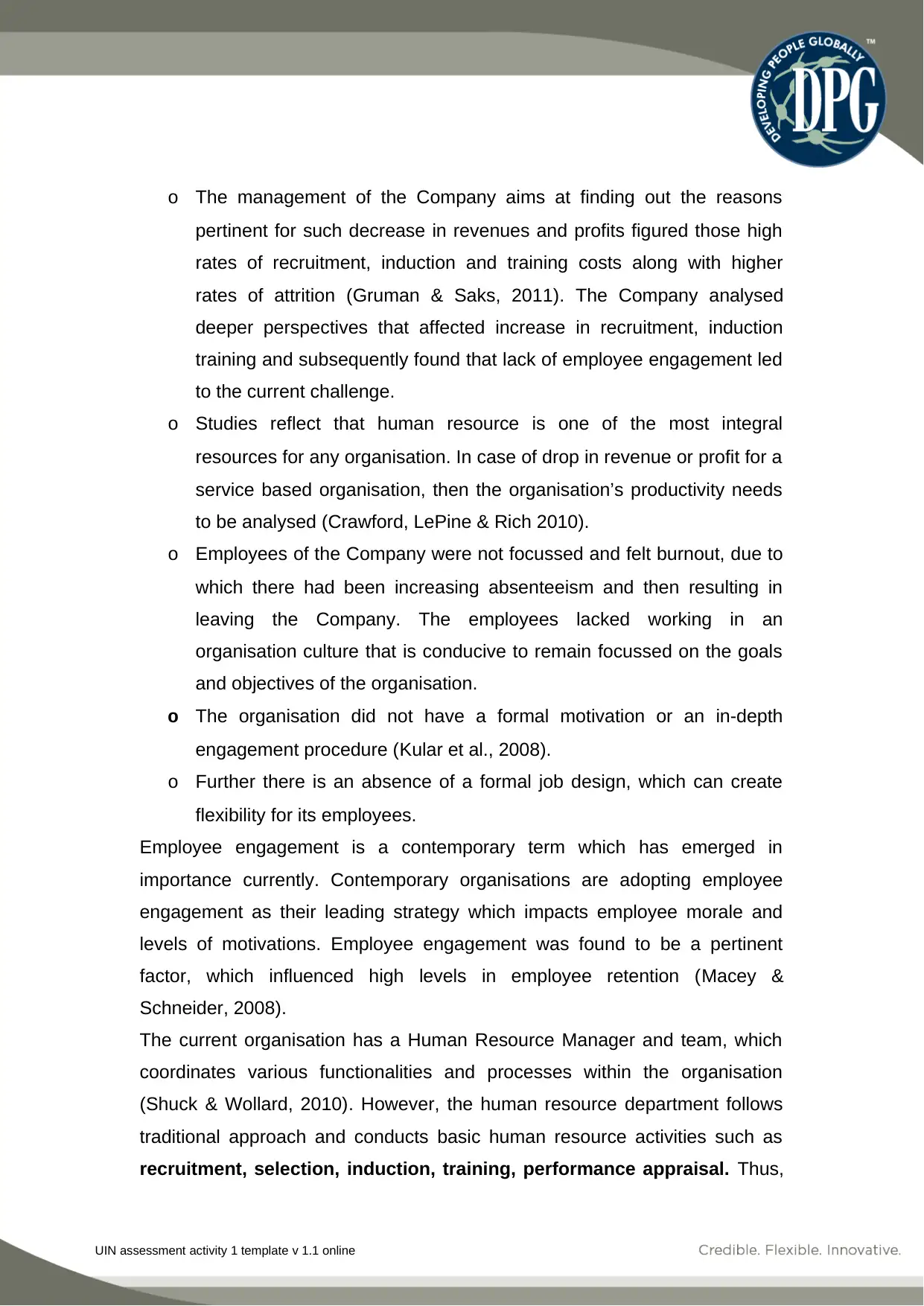
UIN assessment activity 1 template v 1.1 online
o The management of the Company aims at finding out the reasons
pertinent for such decrease in revenues and profits figured those high
rates of recruitment, induction and training costs along with higher
rates of attrition (Gruman & Saks, 2011). The Company analysed
deeper perspectives that affected increase in recruitment, induction
training and subsequently found that lack of employee engagement led
to the current challenge.
o Studies reflect that human resource is one of the most integral
resources for any organisation. In case of drop in revenue or profit for a
service based organisation, then the organisation’s productivity needs
to be analysed (Crawford, LePine & Rich 2010).
o Employees of the Company were not focussed and felt burnout, due to
which there had been increasing absenteeism and then resulting in
leaving the Company. The employees lacked working in an
organisation culture that is conducive to remain focussed on the goals
and objectives of the organisation.
o The organisation did not have a formal motivation or an in-depth
engagement procedure (Kular et al., 2008).
o Further there is an absence of a formal job design, which can create
flexibility for its employees.
Employee engagement is a contemporary term which has emerged in
importance currently. Contemporary organisations are adopting employee
engagement as their leading strategy which impacts employee morale and
levels of motivations. Employee engagement was found to be a pertinent
factor, which influenced high levels in employee retention (Macey &
Schneider, 2008).
The current organisation has a Human Resource Manager and team, which
coordinates various functionalities and processes within the organisation
(Shuck & Wollard, 2010). However, the human resource department follows
traditional approach and conducts basic human resource activities such as
recruitment, selection, induction, training, performance appraisal. Thus,
o The management of the Company aims at finding out the reasons
pertinent for such decrease in revenues and profits figured those high
rates of recruitment, induction and training costs along with higher
rates of attrition (Gruman & Saks, 2011). The Company analysed
deeper perspectives that affected increase in recruitment, induction
training and subsequently found that lack of employee engagement led
to the current challenge.
o Studies reflect that human resource is one of the most integral
resources for any organisation. In case of drop in revenue or profit for a
service based organisation, then the organisation’s productivity needs
to be analysed (Crawford, LePine & Rich 2010).
o Employees of the Company were not focussed and felt burnout, due to
which there had been increasing absenteeism and then resulting in
leaving the Company. The employees lacked working in an
organisation culture that is conducive to remain focussed on the goals
and objectives of the organisation.
o The organisation did not have a formal motivation or an in-depth
engagement procedure (Kular et al., 2008).
o Further there is an absence of a formal job design, which can create
flexibility for its employees.
Employee engagement is a contemporary term which has emerged in
importance currently. Contemporary organisations are adopting employee
engagement as their leading strategy which impacts employee morale and
levels of motivations. Employee engagement was found to be a pertinent
factor, which influenced high levels in employee retention (Macey &
Schneider, 2008).
The current organisation has a Human Resource Manager and team, which
coordinates various functionalities and processes within the organisation
(Shuck & Wollard, 2010). However, the human resource department follows
traditional approach and conducts basic human resource activities such as
recruitment, selection, induction, training, performance appraisal. Thus,
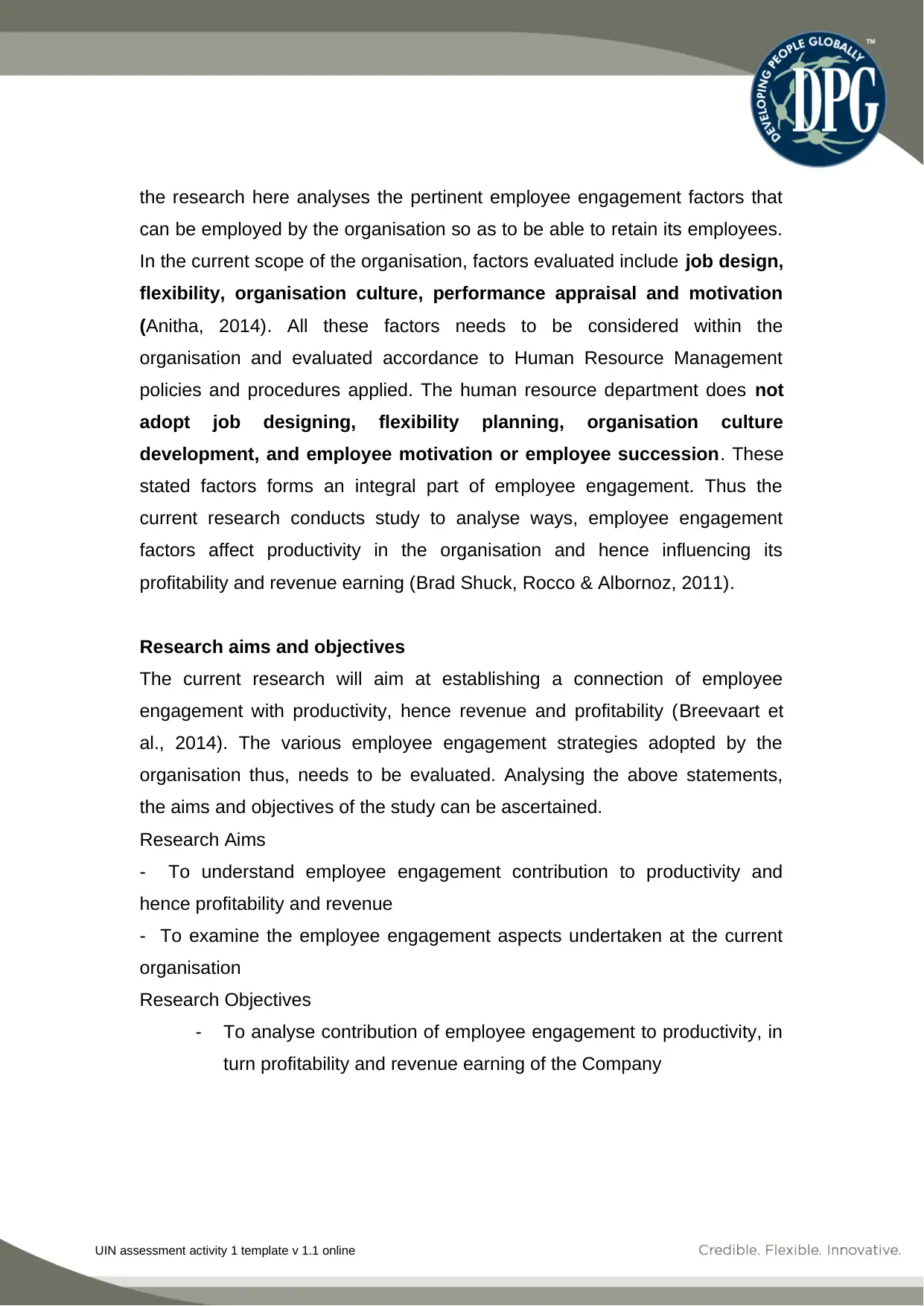
UIN assessment activity 1 template v 1.1 online
the research here analyses the pertinent employee engagement factors that
can be employed by the organisation so as to be able to retain its employees.
In the current scope of the organisation, factors evaluated include job design,
flexibility, organisation culture, performance appraisal and motivation
(Anitha, 2014). All these factors needs to be considered within the
organisation and evaluated accordance to Human Resource Management
policies and procedures applied. The human resource department does not
adopt job designing, flexibility planning, organisation culture
development, and employee motivation or employee succession. These
stated factors forms an integral part of employee engagement. Thus the
current research conducts study to analyse ways, employee engagement
factors affect productivity in the organisation and hence influencing its
profitability and revenue earning (Brad Shuck, Rocco & Albornoz, 2011).
Research aims and objectives
The current research will aim at establishing a connection of employee
engagement with productivity, hence revenue and profitability (Breevaart et
al., 2014). The various employee engagement strategies adopted by the
organisation thus, needs to be evaluated. Analysing the above statements,
the aims and objectives of the study can be ascertained.
Research Aims
- To understand employee engagement contribution to productivity and
hence profitability and revenue
- To examine the employee engagement aspects undertaken at the current
organisation
Research Objectives
- To analyse contribution of employee engagement to productivity, in
turn profitability and revenue earning of the Company
the research here analyses the pertinent employee engagement factors that
can be employed by the organisation so as to be able to retain its employees.
In the current scope of the organisation, factors evaluated include job design,
flexibility, organisation culture, performance appraisal and motivation
(Anitha, 2014). All these factors needs to be considered within the
organisation and evaluated accordance to Human Resource Management
policies and procedures applied. The human resource department does not
adopt job designing, flexibility planning, organisation culture
development, and employee motivation or employee succession. These
stated factors forms an integral part of employee engagement. Thus the
current research conducts study to analyse ways, employee engagement
factors affect productivity in the organisation and hence influencing its
profitability and revenue earning (Brad Shuck, Rocco & Albornoz, 2011).
Research aims and objectives
The current research will aim at establishing a connection of employee
engagement with productivity, hence revenue and profitability (Breevaart et
al., 2014). The various employee engagement strategies adopted by the
organisation thus, needs to be evaluated. Analysing the above statements,
the aims and objectives of the study can be ascertained.
Research Aims
- To understand employee engagement contribution to productivity and
hence profitability and revenue
- To examine the employee engagement aspects undertaken at the current
organisation
Research Objectives
- To analyse contribution of employee engagement to productivity, in
turn profitability and revenue earning of the Company
⊘ This is a preview!⊘
Do you want full access?
Subscribe today to unlock all pages.

Trusted by 1+ million students worldwide
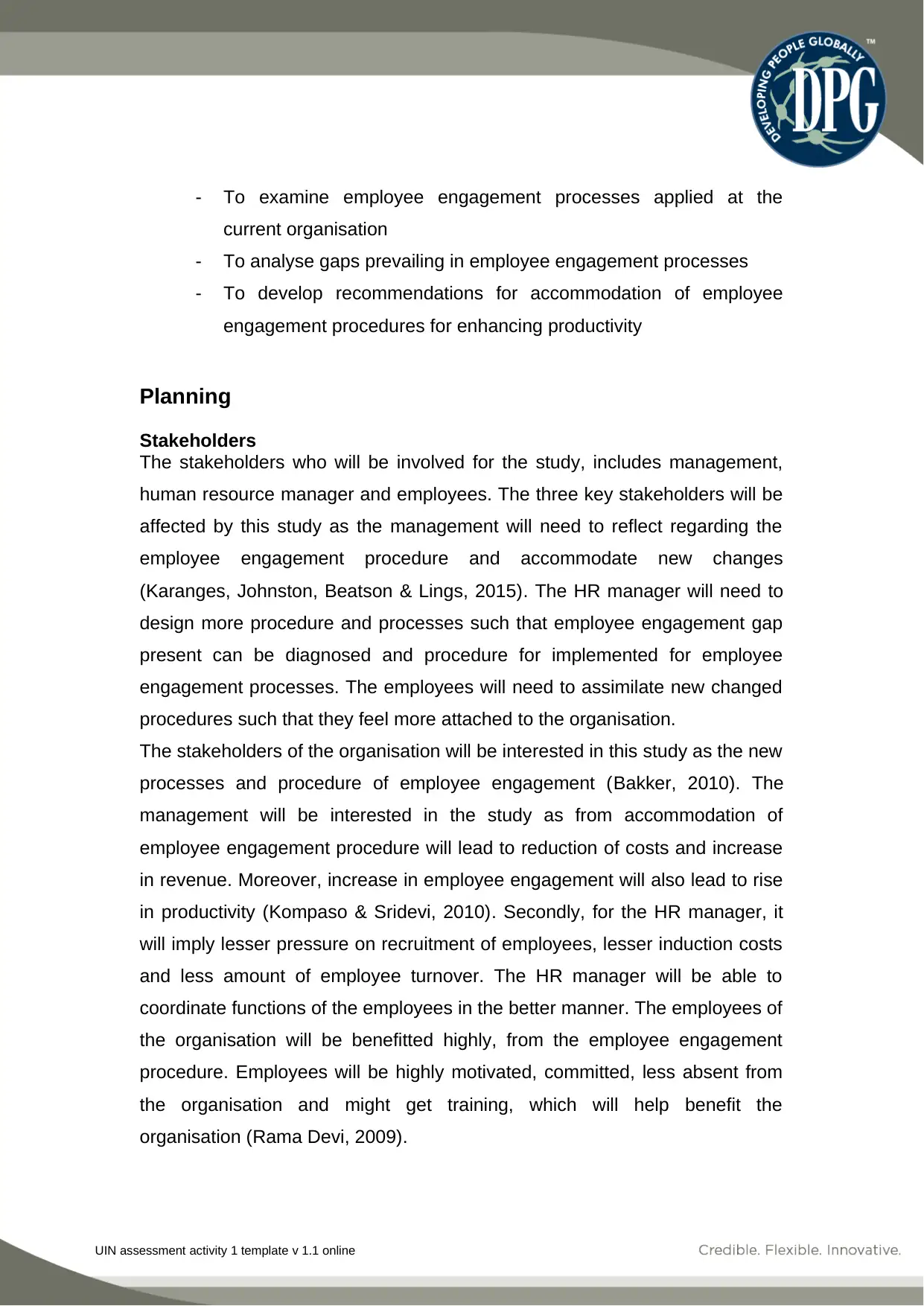
UIN assessment activity 1 template v 1.1 online
- To examine employee engagement processes applied at the
current organisation
- To analyse gaps prevailing in employee engagement processes
- To develop recommendations for accommodation of employee
engagement procedures for enhancing productivity
Planning
Stakeholders
The stakeholders who will be involved for the study, includes management,
human resource manager and employees. The three key stakeholders will be
affected by this study as the management will need to reflect regarding the
employee engagement procedure and accommodate new changes
(Karanges, Johnston, Beatson & Lings, 2015). The HR manager will need to
design more procedure and processes such that employee engagement gap
present can be diagnosed and procedure for implemented for employee
engagement processes. The employees will need to assimilate new changed
procedures such that they feel more attached to the organisation.
The stakeholders of the organisation will be interested in this study as the new
processes and procedure of employee engagement (Bakker, 2010). The
management will be interested in the study as from accommodation of
employee engagement procedure will lead to reduction of costs and increase
in revenue. Moreover, increase in employee engagement will also lead to rise
in productivity (Kompaso & Sridevi, 2010). Secondly, for the HR manager, it
will imply lesser pressure on recruitment of employees, lesser induction costs
and less amount of employee turnover. The HR manager will be able to
coordinate functions of the employees in the better manner. The employees of
the organisation will be benefitted highly, from the employee engagement
procedure. Employees will be highly motivated, committed, less absent from
the organisation and might get training, which will help benefit the
organisation (Rama Devi, 2009).
- To examine employee engagement processes applied at the
current organisation
- To analyse gaps prevailing in employee engagement processes
- To develop recommendations for accommodation of employee
engagement procedures for enhancing productivity
Planning
Stakeholders
The stakeholders who will be involved for the study, includes management,
human resource manager and employees. The three key stakeholders will be
affected by this study as the management will need to reflect regarding the
employee engagement procedure and accommodate new changes
(Karanges, Johnston, Beatson & Lings, 2015). The HR manager will need to
design more procedure and processes such that employee engagement gap
present can be diagnosed and procedure for implemented for employee
engagement processes. The employees will need to assimilate new changed
procedures such that they feel more attached to the organisation.
The stakeholders of the organisation will be interested in this study as the new
processes and procedure of employee engagement (Bakker, 2010). The
management will be interested in the study as from accommodation of
employee engagement procedure will lead to reduction of costs and increase
in revenue. Moreover, increase in employee engagement will also lead to rise
in productivity (Kompaso & Sridevi, 2010). Secondly, for the HR manager, it
will imply lesser pressure on recruitment of employees, lesser induction costs
and less amount of employee turnover. The HR manager will be able to
coordinate functions of the employees in the better manner. The employees of
the organisation will be benefitted highly, from the employee engagement
procedure. Employees will be highly motivated, committed, less absent from
the organisation and might get training, which will help benefit the
organisation (Rama Devi, 2009).
Paraphrase This Document
Need a fresh take? Get an instant paraphrase of this document with our AI Paraphraser
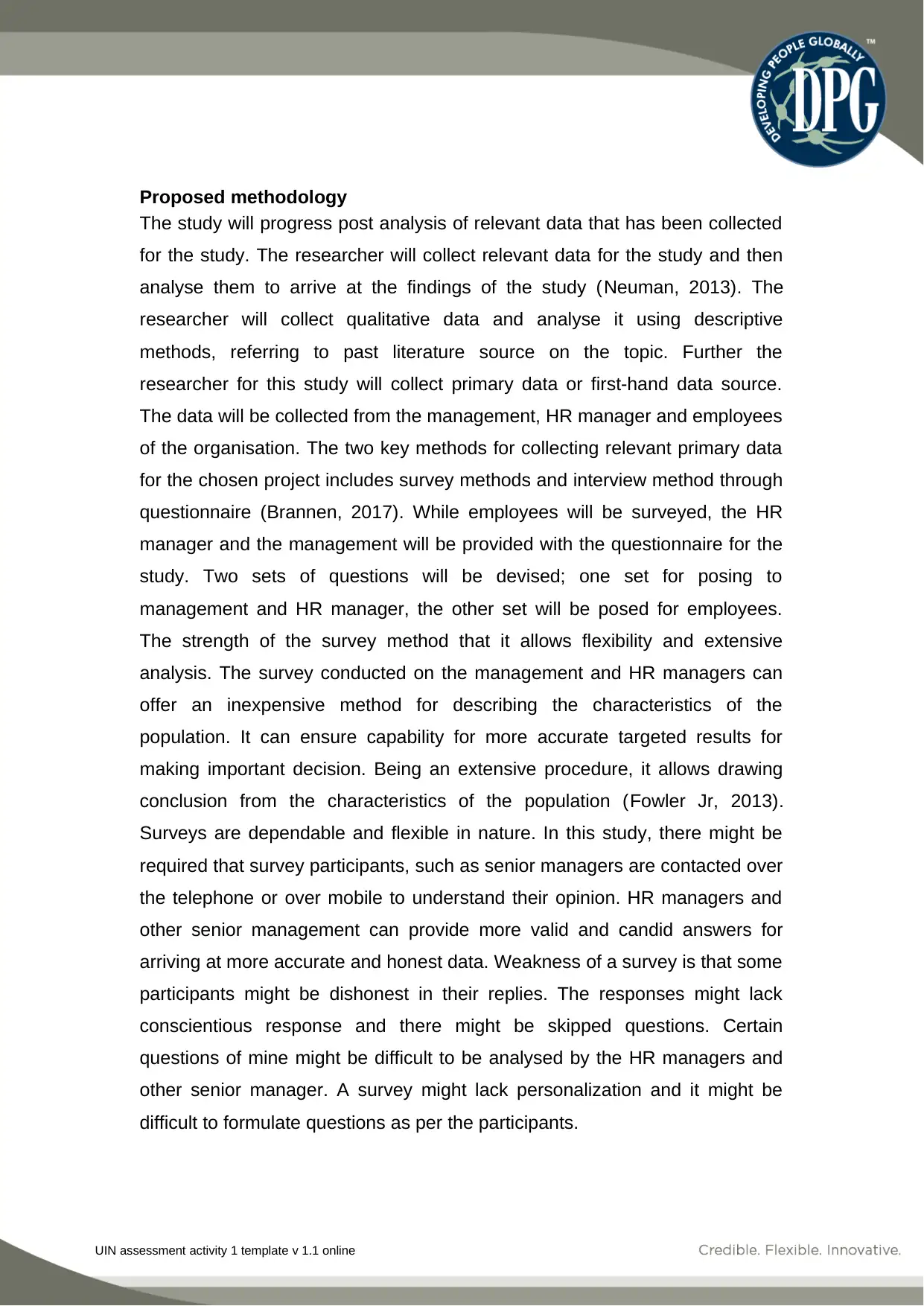
UIN assessment activity 1 template v 1.1 online
Proposed methodology
The study will progress post analysis of relevant data that has been collected
for the study. The researcher will collect relevant data for the study and then
analyse them to arrive at the findings of the study (Neuman, 2013). The
researcher will collect qualitative data and analyse it using descriptive
methods, referring to past literature source on the topic. Further the
researcher for this study will collect primary data or first-hand data source.
The data will be collected from the management, HR manager and employees
of the organisation. The two key methods for collecting relevant primary data
for the chosen project includes survey methods and interview method through
questionnaire (Brannen, 2017). While employees will be surveyed, the HR
manager and the management will be provided with the questionnaire for the
study. Two sets of questions will be devised; one set for posing to
management and HR manager, the other set will be posed for employees.
The strength of the survey method that it allows flexibility and extensive
analysis. The survey conducted on the management and HR managers can
offer an inexpensive method for describing the characteristics of the
population. It can ensure capability for more accurate targeted results for
making important decision. Being an extensive procedure, it allows drawing
conclusion from the characteristics of the population (Fowler Jr, 2013).
Surveys are dependable and flexible in nature. In this study, there might be
required that survey participants, such as senior managers are contacted over
the telephone or over mobile to understand their opinion. HR managers and
other senior management can provide more valid and candid answers for
arriving at more accurate and honest data. Weakness of a survey is that some
participants might be dishonest in their replies. The responses might lack
conscientious response and there might be skipped questions. Certain
questions of mine might be difficult to be analysed by the HR managers and
other senior manager. A survey might lack personalization and it might be
difficult to formulate questions as per the participants.
Proposed methodology
The study will progress post analysis of relevant data that has been collected
for the study. The researcher will collect relevant data for the study and then
analyse them to arrive at the findings of the study (Neuman, 2013). The
researcher will collect qualitative data and analyse it using descriptive
methods, referring to past literature source on the topic. Further the
researcher for this study will collect primary data or first-hand data source.
The data will be collected from the management, HR manager and employees
of the organisation. The two key methods for collecting relevant primary data
for the chosen project includes survey methods and interview method through
questionnaire (Brannen, 2017). While employees will be surveyed, the HR
manager and the management will be provided with the questionnaire for the
study. Two sets of questions will be devised; one set for posing to
management and HR manager, the other set will be posed for employees.
The strength of the survey method that it allows flexibility and extensive
analysis. The survey conducted on the management and HR managers can
offer an inexpensive method for describing the characteristics of the
population. It can ensure capability for more accurate targeted results for
making important decision. Being an extensive procedure, it allows drawing
conclusion from the characteristics of the population (Fowler Jr, 2013).
Surveys are dependable and flexible in nature. In this study, there might be
required that survey participants, such as senior managers are contacted over
the telephone or over mobile to understand their opinion. HR managers and
other senior management can provide more valid and candid answers for
arriving at more accurate and honest data. Weakness of a survey is that some
participants might be dishonest in their replies. The responses might lack
conscientious response and there might be skipped questions. Certain
questions of mine might be difficult to be analysed by the HR managers and
other senior manager. A survey might lack personalization and it might be
difficult to formulate questions as per the participants.
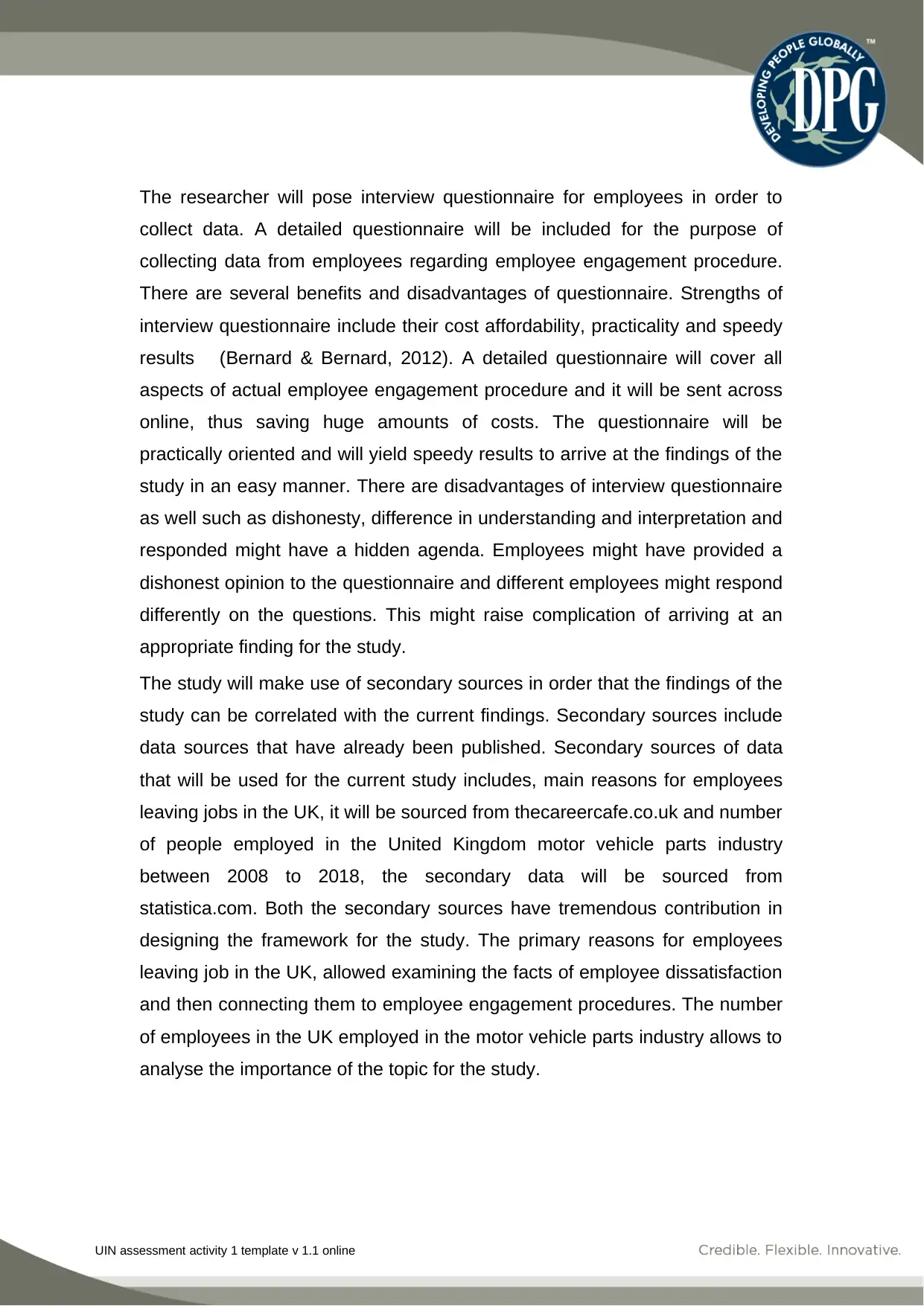
UIN assessment activity 1 template v 1.1 online
The researcher will pose interview questionnaire for employees in order to
collect data. A detailed questionnaire will be included for the purpose of
collecting data from employees regarding employee engagement procedure.
There are several benefits and disadvantages of questionnaire. Strengths of
interview questionnaire include their cost affordability, practicality and speedy
results (Bernard & Bernard, 2012). A detailed questionnaire will cover all
aspects of actual employee engagement procedure and it will be sent across
online, thus saving huge amounts of costs. The questionnaire will be
practically oriented and will yield speedy results to arrive at the findings of the
study in an easy manner. There are disadvantages of interview questionnaire
as well such as dishonesty, difference in understanding and interpretation and
responded might have a hidden agenda. Employees might have provided a
dishonest opinion to the questionnaire and different employees might respond
differently on the questions. This might raise complication of arriving at an
appropriate finding for the study.
The study will make use of secondary sources in order that the findings of the
study can be correlated with the current findings. Secondary sources include
data sources that have already been published. Secondary sources of data
that will be used for the current study includes, main reasons for employees
leaving jobs in the UK, it will be sourced from thecareercafe.co.uk and number
of people employed in the United Kingdom motor vehicle parts industry
between 2008 to 2018, the secondary data will be sourced from
statistica.com. Both the secondary sources have tremendous contribution in
designing the framework for the study. The primary reasons for employees
leaving job in the UK, allowed examining the facts of employee dissatisfaction
and then connecting them to employee engagement procedures. The number
of employees in the UK employed in the motor vehicle parts industry allows to
analyse the importance of the topic for the study.
The researcher will pose interview questionnaire for employees in order to
collect data. A detailed questionnaire will be included for the purpose of
collecting data from employees regarding employee engagement procedure.
There are several benefits and disadvantages of questionnaire. Strengths of
interview questionnaire include their cost affordability, practicality and speedy
results (Bernard & Bernard, 2012). A detailed questionnaire will cover all
aspects of actual employee engagement procedure and it will be sent across
online, thus saving huge amounts of costs. The questionnaire will be
practically oriented and will yield speedy results to arrive at the findings of the
study in an easy manner. There are disadvantages of interview questionnaire
as well such as dishonesty, difference in understanding and interpretation and
responded might have a hidden agenda. Employees might have provided a
dishonest opinion to the questionnaire and different employees might respond
differently on the questions. This might raise complication of arriving at an
appropriate finding for the study.
The study will make use of secondary sources in order that the findings of the
study can be correlated with the current findings. Secondary sources include
data sources that have already been published. Secondary sources of data
that will be used for the current study includes, main reasons for employees
leaving jobs in the UK, it will be sourced from thecareercafe.co.uk and number
of people employed in the United Kingdom motor vehicle parts industry
between 2008 to 2018, the secondary data will be sourced from
statistica.com. Both the secondary sources have tremendous contribution in
designing the framework for the study. The primary reasons for employees
leaving job in the UK, allowed examining the facts of employee dissatisfaction
and then connecting them to employee engagement procedures. The number
of employees in the UK employed in the motor vehicle parts industry allows to
analyse the importance of the topic for the study.
⊘ This is a preview!⊘
Do you want full access?
Subscribe today to unlock all pages.

Trusted by 1+ million students worldwide
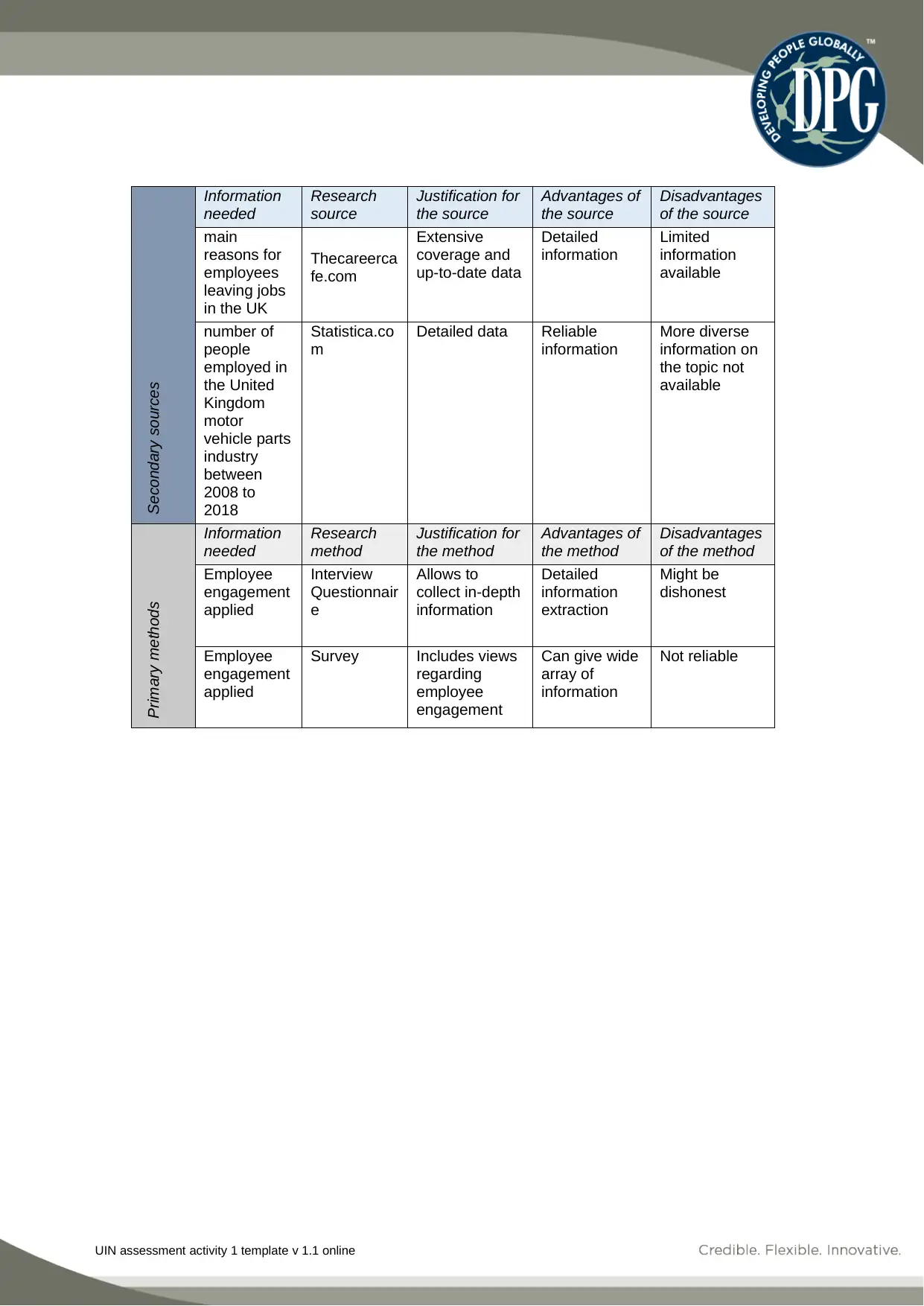
UIN assessment activity 1 template v 1.1 online
Secondary sources
Information
needed
Research
source
Justification for
the source
Advantages of
the source
Disadvantages
of the source
main
reasons for
employees
leaving jobs
in the UK
Thecareerca
fe.com
Extensive
coverage and
up-to-date data
Detailed
information
Limited
information
available
number of
people
employed in
the United
Kingdom
motor
vehicle parts
industry
between
2008 to
2018
Statistica.co
m
Detailed data Reliable
information
More diverse
information on
the topic not
available
Primary methods
Information
needed
Research
method
Justification for
the method
Advantages of
the method
Disadvantages
of the method
Employee
engagement
applied
Interview
Questionnair
e
Allows to
collect in-depth
information
Detailed
information
extraction
Might be
dishonest
Employee
engagement
applied
Survey Includes views
regarding
employee
engagement
Can give wide
array of
information
Not reliable
Secondary sources
Information
needed
Research
source
Justification for
the source
Advantages of
the source
Disadvantages
of the source
main
reasons for
employees
leaving jobs
in the UK
Thecareerca
fe.com
Extensive
coverage and
up-to-date data
Detailed
information
Limited
information
available
number of
people
employed in
the United
Kingdom
motor
vehicle parts
industry
between
2008 to
2018
Statistica.co
m
Detailed data Reliable
information
More diverse
information on
the topic not
available
Primary methods
Information
needed
Research
method
Justification for
the method
Advantages of
the method
Disadvantages
of the method
Employee
engagement
applied
Interview
Questionnair
e
Allows to
collect in-depth
information
Detailed
information
extraction
Might be
dishonest
Employee
engagement
applied
Survey Includes views
regarding
employee
engagement
Can give wide
array of
information
Not reliable
Paraphrase This Document
Need a fresh take? Get an instant paraphrase of this document with our AI Paraphraser
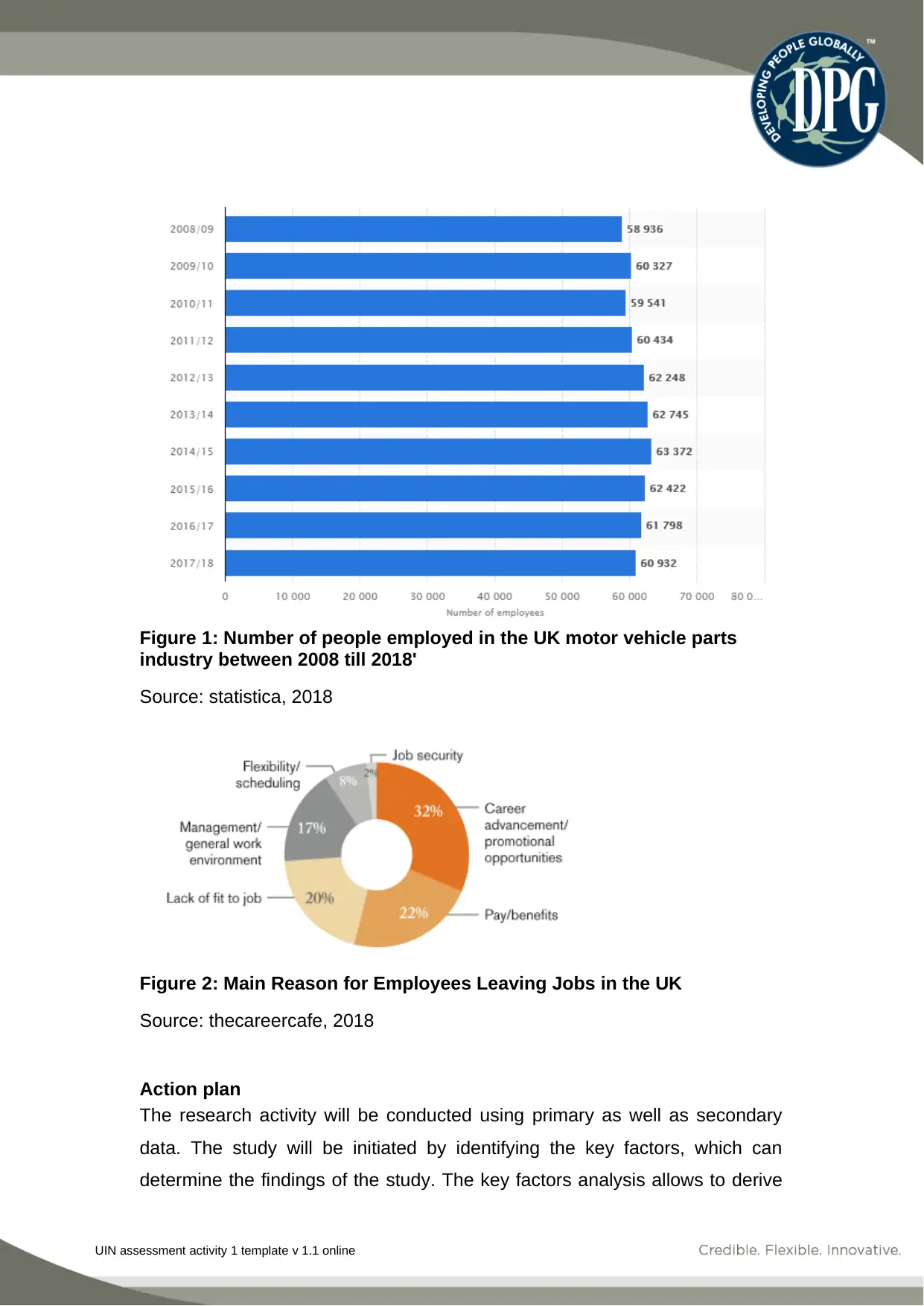
UIN assessment activity 1 template v 1.1 online
Figure 1: Number of people employed in the UK motor vehicle parts
industry between 2008 till 2018'
Source: statistica, 2018
Figure 2: Main Reason for Employees Leaving Jobs in the UK
Source: thecareercafe, 2018
Action plan
The research activity will be conducted using primary as well as secondary
data. The study will be initiated by identifying the key factors, which can
determine the findings of the study. The key factors analysis allows to derive
Figure 1: Number of people employed in the UK motor vehicle parts
industry between 2008 till 2018'
Source: statistica, 2018
Figure 2: Main Reason for Employees Leaving Jobs in the UK
Source: thecareercafe, 2018
Action plan
The research activity will be conducted using primary as well as secondary
data. The study will be initiated by identifying the key factors, which can
determine the findings of the study. The key factors analysis allows to derive
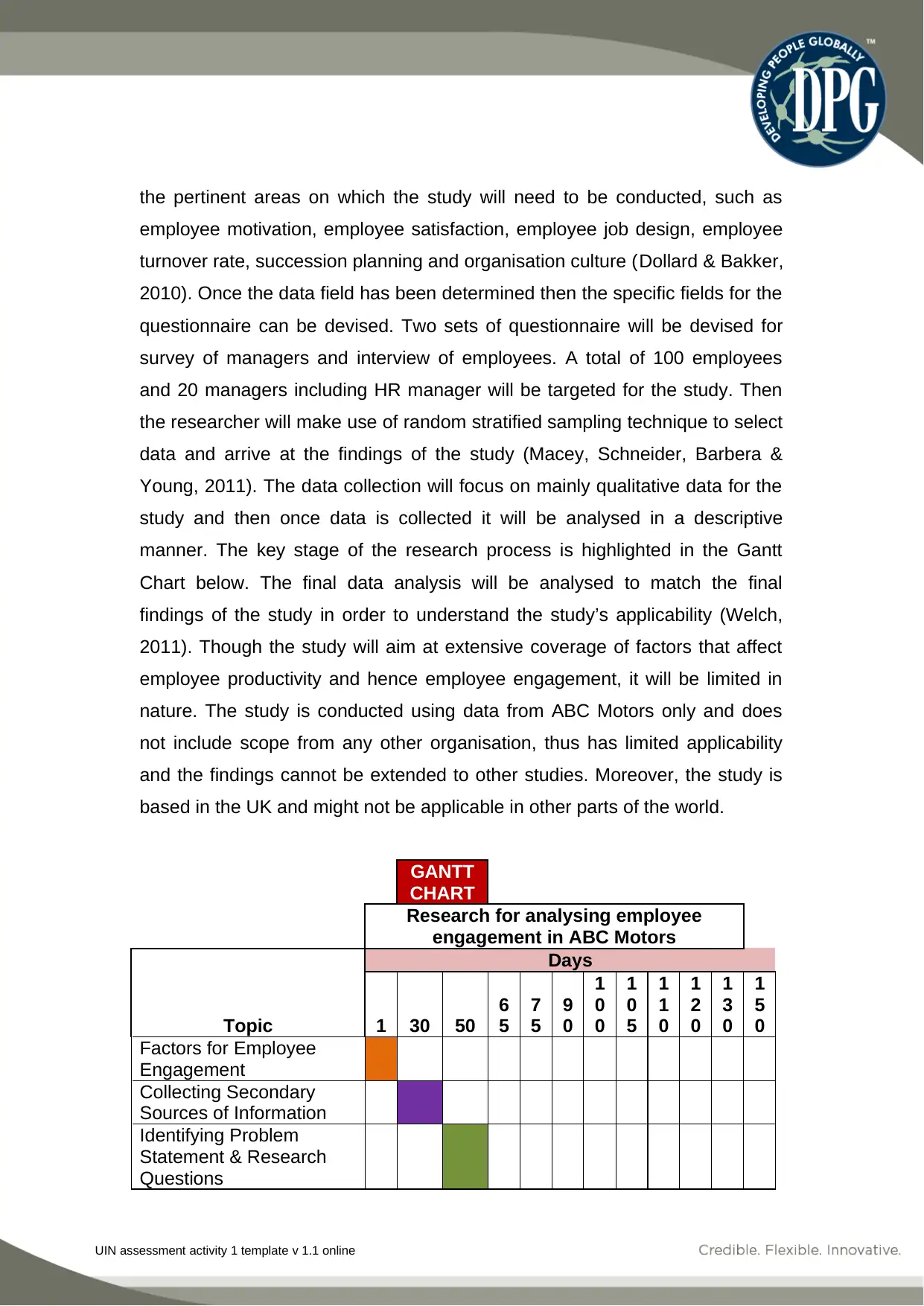
UIN assessment activity 1 template v 1.1 online
the pertinent areas on which the study will need to be conducted, such as
employee motivation, employee satisfaction, employee job design, employee
turnover rate, succession planning and organisation culture (Dollard & Bakker,
2010). Once the data field has been determined then the specific fields for the
questionnaire can be devised. Two sets of questionnaire will be devised for
survey of managers and interview of employees. A total of 100 employees
and 20 managers including HR manager will be targeted for the study. Then
the researcher will make use of random stratified sampling technique to select
data and arrive at the findings of the study (Macey, Schneider, Barbera &
Young, 2011). The data collection will focus on mainly qualitative data for the
study and then once data is collected it will be analysed in a descriptive
manner. The key stage of the research process is highlighted in the Gantt
Chart below. The final data analysis will be analysed to match the final
findings of the study in order to understand the study’s applicability (Welch,
2011). Though the study will aim at extensive coverage of factors that affect
employee productivity and hence employee engagement, it will be limited in
nature. The study is conducted using data from ABC Motors only and does
not include scope from any other organisation, thus has limited applicability
and the findings cannot be extended to other studies. Moreover, the study is
based in the UK and might not be applicable in other parts of the world.
GANTT
CHART
Research for analysing employee
engagement in ABC Motors
Topic
Days
1 30 50
6
5
7
5
9
0
1
0
0
1
0
5
1
1
0
1
2
0
1
3
0
1
5
0
Factors for Employee
Engagement
Collecting Secondary
Sources of Information
Identifying Problem
Statement & Research
Questions
the pertinent areas on which the study will need to be conducted, such as
employee motivation, employee satisfaction, employee job design, employee
turnover rate, succession planning and organisation culture (Dollard & Bakker,
2010). Once the data field has been determined then the specific fields for the
questionnaire can be devised. Two sets of questionnaire will be devised for
survey of managers and interview of employees. A total of 100 employees
and 20 managers including HR manager will be targeted for the study. Then
the researcher will make use of random stratified sampling technique to select
data and arrive at the findings of the study (Macey, Schneider, Barbera &
Young, 2011). The data collection will focus on mainly qualitative data for the
study and then once data is collected it will be analysed in a descriptive
manner. The key stage of the research process is highlighted in the Gantt
Chart below. The final data analysis will be analysed to match the final
findings of the study in order to understand the study’s applicability (Welch,
2011). Though the study will aim at extensive coverage of factors that affect
employee productivity and hence employee engagement, it will be limited in
nature. The study is conducted using data from ABC Motors only and does
not include scope from any other organisation, thus has limited applicability
and the findings cannot be extended to other studies. Moreover, the study is
based in the UK and might not be applicable in other parts of the world.
GANTT
CHART
Research for analysing employee
engagement in ABC Motors
Topic
Days
1 30 50
6
5
7
5
9
0
1
0
0
1
0
5
1
1
0
1
2
0
1
3
0
1
5
0
Factors for Employee
Engagement
Collecting Secondary
Sources of Information
Identifying Problem
Statement & Research
Questions
⊘ This is a preview!⊘
Do you want full access?
Subscribe today to unlock all pages.

Trusted by 1+ million students worldwide
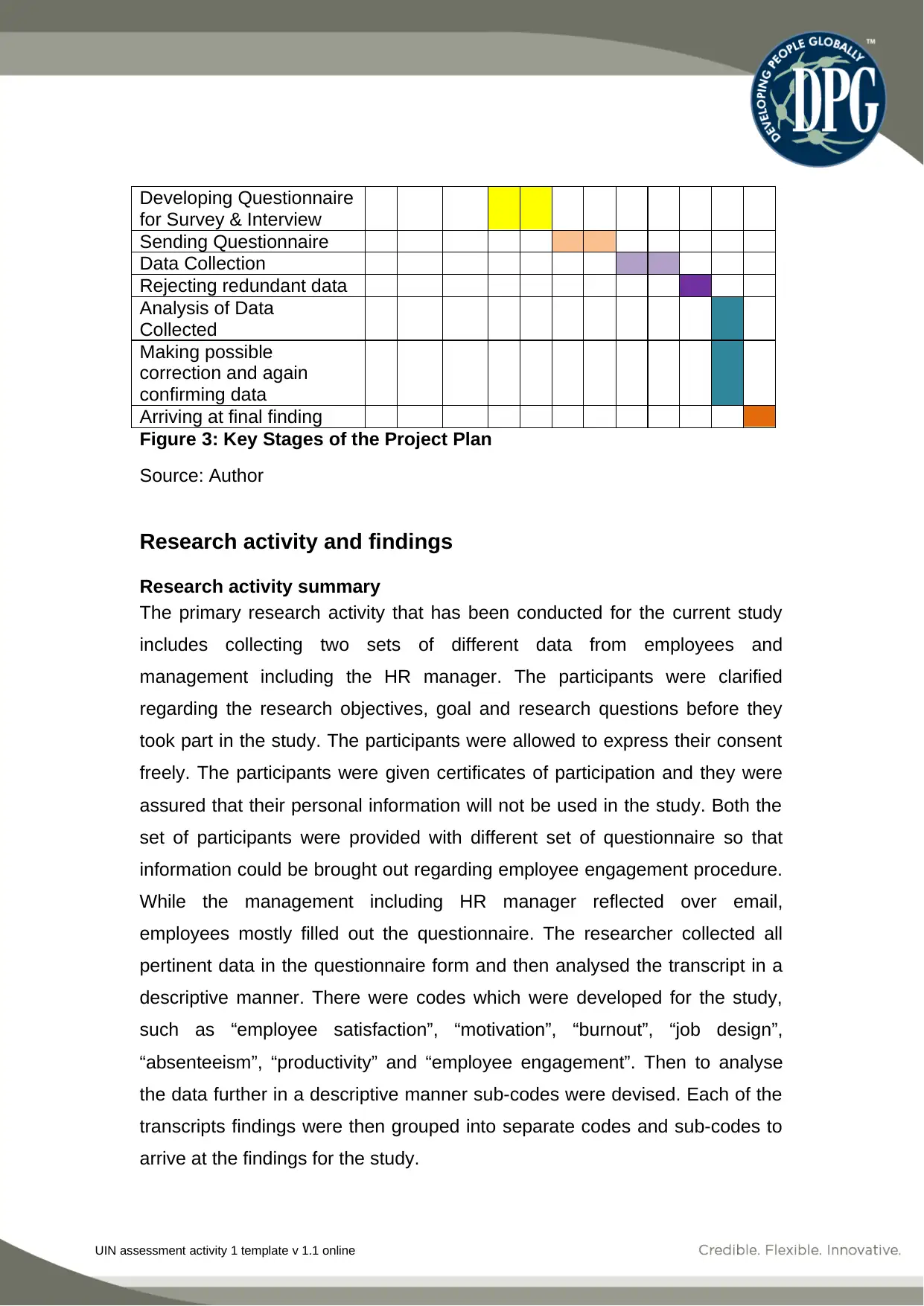
UIN assessment activity 1 template v 1.1 online
Developing Questionnaire
for Survey & Interview
Sending Questionnaire
Data Collection
Rejecting redundant data
Analysis of Data
Collected
Making possible
correction and again
confirming data
Arriving at final finding
Figure 3: Key Stages of the Project Plan
Source: Author
Research activity and findings
Research activity summary
The primary research activity that has been conducted for the current study
includes collecting two sets of different data from employees and
management including the HR manager. The participants were clarified
regarding the research objectives, goal and research questions before they
took part in the study. The participants were allowed to express their consent
freely. The participants were given certificates of participation and they were
assured that their personal information will not be used in the study. Both the
set of participants were provided with different set of questionnaire so that
information could be brought out regarding employee engagement procedure.
While the management including HR manager reflected over email,
employees mostly filled out the questionnaire. The researcher collected all
pertinent data in the questionnaire form and then analysed the transcript in a
descriptive manner. There were codes which were developed for the study,
such as “employee satisfaction”, “motivation”, “burnout”, “job design”,
“absenteeism”, “productivity” and “employee engagement”. Then to analyse
the data further in a descriptive manner sub-codes were devised. Each of the
transcripts findings were then grouped into separate codes and sub-codes to
arrive at the findings for the study.
Developing Questionnaire
for Survey & Interview
Sending Questionnaire
Data Collection
Rejecting redundant data
Analysis of Data
Collected
Making possible
correction and again
confirming data
Arriving at final finding
Figure 3: Key Stages of the Project Plan
Source: Author
Research activity and findings
Research activity summary
The primary research activity that has been conducted for the current study
includes collecting two sets of different data from employees and
management including the HR manager. The participants were clarified
regarding the research objectives, goal and research questions before they
took part in the study. The participants were allowed to express their consent
freely. The participants were given certificates of participation and they were
assured that their personal information will not be used in the study. Both the
set of participants were provided with different set of questionnaire so that
information could be brought out regarding employee engagement procedure.
While the management including HR manager reflected over email,
employees mostly filled out the questionnaire. The researcher collected all
pertinent data in the questionnaire form and then analysed the transcript in a
descriptive manner. There were codes which were developed for the study,
such as “employee satisfaction”, “motivation”, “burnout”, “job design”,
“absenteeism”, “productivity” and “employee engagement”. Then to analyse
the data further in a descriptive manner sub-codes were devised. Each of the
transcripts findings were then grouped into separate codes and sub-codes to
arrive at the findings for the study.
Paraphrase This Document
Need a fresh take? Get an instant paraphrase of this document with our AI Paraphraser
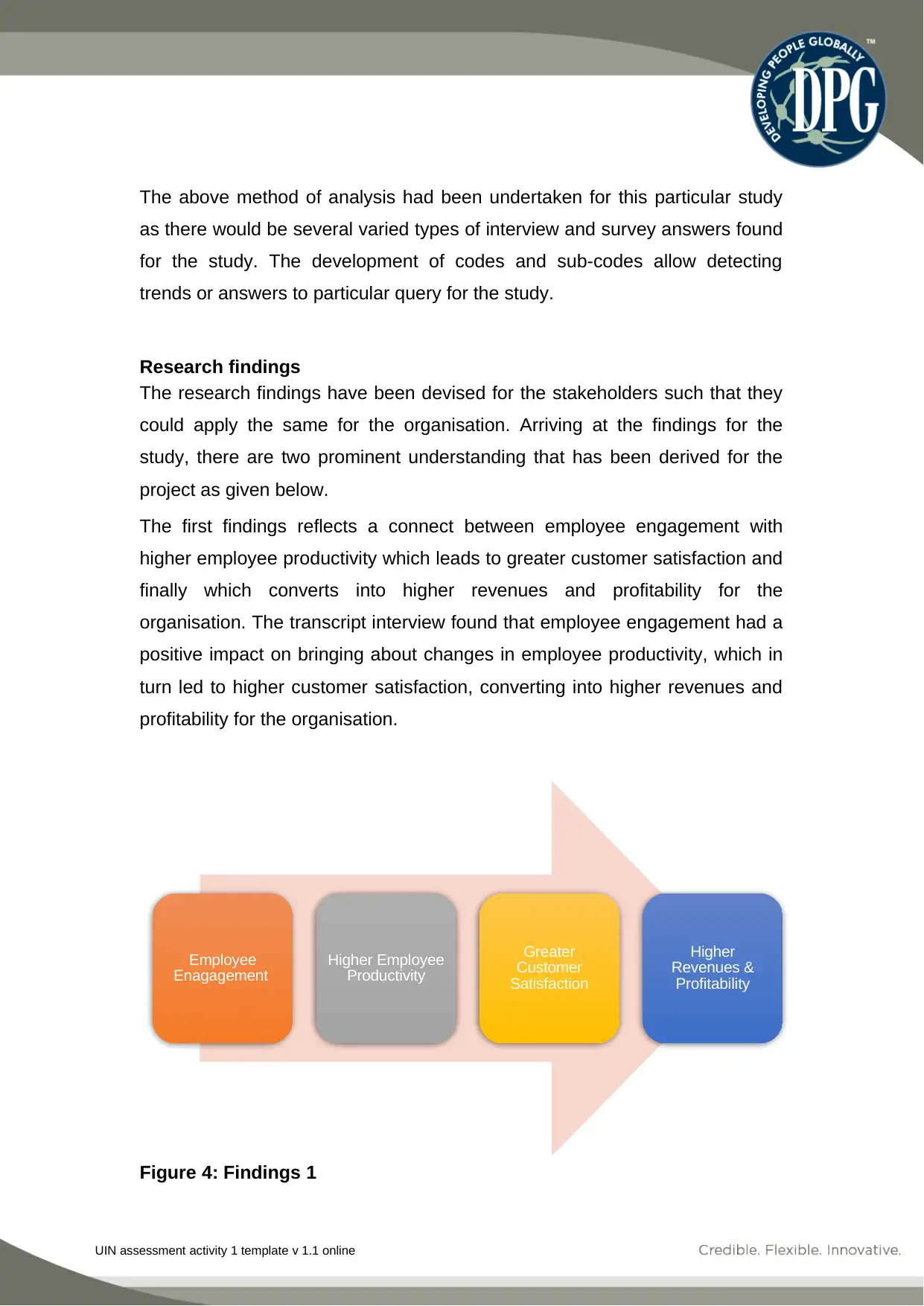
UIN assessment activity 1 template v 1.1 online
The above method of analysis had been undertaken for this particular study
as there would be several varied types of interview and survey answers found
for the study. The development of codes and sub-codes allow detecting
trends or answers to particular query for the study.
Research findings
The research findings have been devised for the stakeholders such that they
could apply the same for the organisation. Arriving at the findings for the
study, there are two prominent understanding that has been derived for the
project as given below.
The first findings reflects a connect between employee engagement with
higher employee productivity which leads to greater customer satisfaction and
finally which converts into higher revenues and profitability for the
organisation. The transcript interview found that employee engagement had a
positive impact on bringing about changes in employee productivity, which in
turn led to higher customer satisfaction, converting into higher revenues and
profitability for the organisation.
Figure 4: Findings 1
Employee
Enagagement
Higher Employee
Productivity
Greater
Customer
Satisfaction
Higher
Revenues &
Profitability
The above method of analysis had been undertaken for this particular study
as there would be several varied types of interview and survey answers found
for the study. The development of codes and sub-codes allow detecting
trends or answers to particular query for the study.
Research findings
The research findings have been devised for the stakeholders such that they
could apply the same for the organisation. Arriving at the findings for the
study, there are two prominent understanding that has been derived for the
project as given below.
The first findings reflects a connect between employee engagement with
higher employee productivity which leads to greater customer satisfaction and
finally which converts into higher revenues and profitability for the
organisation. The transcript interview found that employee engagement had a
positive impact on bringing about changes in employee productivity, which in
turn led to higher customer satisfaction, converting into higher revenues and
profitability for the organisation.
Figure 4: Findings 1
Employee
Enagagement
Higher Employee
Productivity
Greater
Customer
Satisfaction
Higher
Revenues &
Profitability
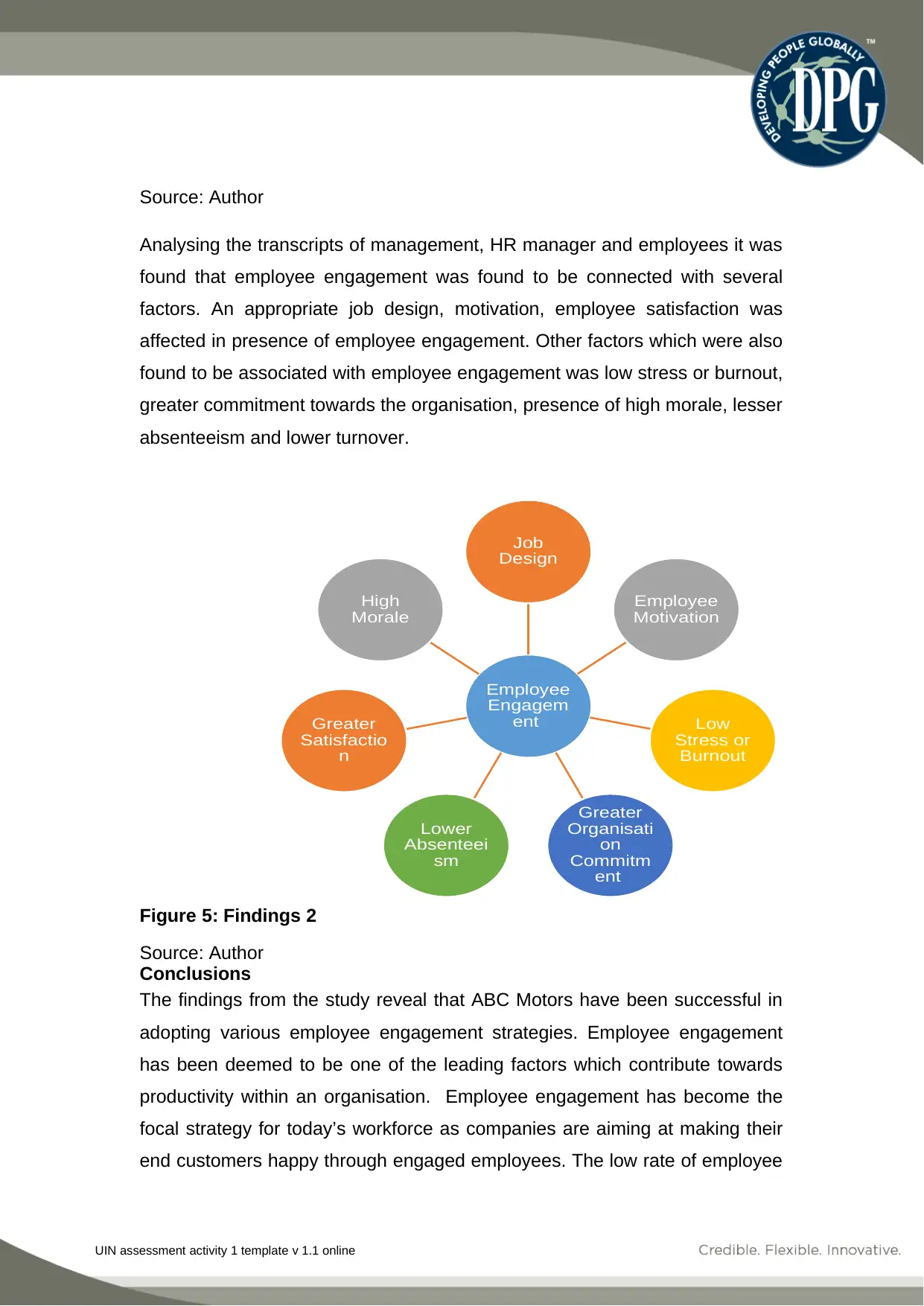
UIN assessment activity 1 template v 1.1 online
Source: Author
Analysing the transcripts of management, HR manager and employees it was
found that employee engagement was found to be connected with several
factors. An appropriate job design, motivation, employee satisfaction was
affected in presence of employee engagement. Other factors which were also
found to be associated with employee engagement was low stress or burnout,
greater commitment towards the organisation, presence of high morale, lesser
absenteeism and lower turnover.
Figure 5: Findings 2
Source: Author
Conclusions
The findings from the study reveal that ABC Motors have been successful in
adopting various employee engagement strategies. Employee engagement
has been deemed to be one of the leading factors which contribute towards
productivity within an organisation. Employee engagement has become the
focal strategy for today’s workforce as companies are aiming at making their
end customers happy through engaged employees. The low rate of employee
Employee
Engagem
ent
Job
Design
Employee
Motivation
Low
Stress or
Burnout
Greater
Organisati
on
Commitm
ent
Lower
Absenteei
sm
Greater
Satisfactio
n
High
Morale
Source: Author
Analysing the transcripts of management, HR manager and employees it was
found that employee engagement was found to be connected with several
factors. An appropriate job design, motivation, employee satisfaction was
affected in presence of employee engagement. Other factors which were also
found to be associated with employee engagement was low stress or burnout,
greater commitment towards the organisation, presence of high morale, lesser
absenteeism and lower turnover.
Figure 5: Findings 2
Source: Author
Conclusions
The findings from the study reveal that ABC Motors have been successful in
adopting various employee engagement strategies. Employee engagement
has been deemed to be one of the leading factors which contribute towards
productivity within an organisation. Employee engagement has become the
focal strategy for today’s workforce as companies are aiming at making their
end customers happy through engaged employees. The low rate of employee
Employee
Engagem
ent
Job
Design
Employee
Motivation
Low
Stress or
Burnout
Greater
Organisati
on
Commitm
ent
Lower
Absenteei
sm
Greater
Satisfactio
n
High
Morale
⊘ This is a preview!⊘
Do you want full access?
Subscribe today to unlock all pages.

Trusted by 1+ million students worldwide
1 out of 17
Related Documents
Your All-in-One AI-Powered Toolkit for Academic Success.
+13062052269
info@desklib.com
Available 24*7 on WhatsApp / Email
![[object Object]](/_next/static/media/star-bottom.7253800d.svg)
Unlock your academic potential
Copyright © 2020–2025 A2Z Services. All Rights Reserved. Developed and managed by ZUCOL.





